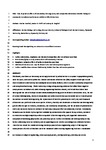Time-dependent effects of orientation, heterogeneity and composition determines benthic biological community recruitment patterns on subtidal artificial structures
| dc.contributor.author | Hanlon, N | |
| dc.contributor.author | Firth, Louise | |
| dc.contributor.author | Knights, Antony | |
| dc.date.accessioned | 2018-08-13T14:41:30Z | |
| dc.date.issued | 2018-10-15 | |
| dc.identifier.issn | 0925-8574 | |
| dc.identifier.issn | 1872-6992 | |
| dc.identifier.uri | http://hdl.handle.net/10026.1/12106 | |
| dc.description.abstract |
Worldwide, coastlines are becoming increasingly hardened by infrastructure in response to population growth, need for space, and coastal protection. Coastal and marine infrastructure (CMI) supports fewer species and lower abundance and diversity than analogous natural rocky habitats, which can alter community composition and ecosystem functioning. Efforts to develop ecological engineering solutions that offset these negative consequences on biodiversity while retaining engineering function abound, but to date few studies have investigated the role of multiple factors simultaneously driving patterns of biotic colonisation. Here, the role of surface heterogeneity, chemical composition and surface orientation was evaluated over a 6-month period. An increase in habitat heterogeneity, the replacement of shale for ground oyster shell (cue) and downward orientation was predicted to increase species richness, diversity and abundance. Orientation and heterogeneity greatly affected species richness, abundance, and community composition, and the inclusion of ground oyster shell (cue) increased bivalve recruitment but had only a marginal effect on community structure. Community formation was facilitated by low light but inhibited by sedimentation. On upward-facing surfaces, sediment accumulation on high complexity surfaces expanded niche heterogeneity, and supported communities comprised of burrowing polychaetes and predatory species. Surface orientation and heterogeneity are key factors influencing larval recruitment, and in supporting diverse benthic assemblages on artificial structures. These factors should be considered during the design phase of new engineering projects if the negative consequences of artificial structures are to be minimised while ensuring engineering function is maintained. | |
| dc.format.extent | 219-228 | |
| dc.language | en | |
| dc.language.iso | en | |
| dc.publisher | Elsevier | |
| dc.subject | Ecological engineering | |
| dc.subject | Urban sprawl | |
| dc.subject | Dynamics | |
| dc.subject | Intelligent design | |
| dc.subject | Selection | |
| dc.subject | Succession | |
| dc.title | Time-dependent effects of orientation, heterogeneity and composition determines benthic biological community recruitment patterns on subtidal artificial structures | |
| dc.type | journal-article | |
| dc.type | Journal Article | |
| plymouth.author-url | https://www.webofscience.com/api/gateway?GWVersion=2&SrcApp=PARTNER_APP&SrcAuth=LinksAMR&KeyUT=WOS:000444616000027&DestLinkType=FullRecord&DestApp=ALL_WOS&UsrCustomerID=11bb513d99f797142bcfeffcc58ea008 | |
| plymouth.volume | 122 | |
| plymouth.publication-status | Published | |
| plymouth.journal | Ecological Engineering | |
| dc.identifier.doi | 10.1016/j.ecoleng.2018.08.013 | |
| plymouth.organisational-group | /Plymouth | |
| plymouth.organisational-group | /Plymouth/Faculty of Science and Engineering | |
| plymouth.organisational-group | /Plymouth/Faculty of Science and Engineering/School of Biological and Marine Sciences | |
| plymouth.organisational-group | /Plymouth/REF 2021 Researchers by UoA | |
| plymouth.organisational-group | /Plymouth/REF 2021 Researchers by UoA/UoA07 Earth Systems and Environmental Sciences | |
| plymouth.organisational-group | /Plymouth/Users by role | |
| plymouth.organisational-group | /Plymouth/Users by role/Academics | |
| plymouth.organisational-group | /Plymouth/Users by role/Researchers in ResearchFish submission | |
| dcterms.dateAccepted | 2018-08-13 | |
| dc.rights.embargodate | 2019-8-16 | |
| dc.identifier.eissn | 1872-6992 | |
| dc.rights.embargoperiod | Not known | |
| rioxxterms.versionofrecord | 10.1016/j.ecoleng.2018.08.013 | |
| rioxxterms.licenseref.uri | http://www.rioxx.net/licenses/all-rights-reserved | |
| rioxxterms.licenseref.startdate | 2018-10-15 | |
| rioxxterms.type | Journal Article/Review |


